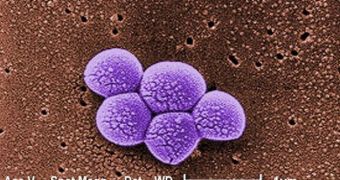Hospitals have become over recent years the top places where patients can get bacterial infections from, in spite of experts' best efforts to disinfect the buildings. It would appear that resilient bacteria such as the Methicillin-resistant Staphylococcus aureus (MRSA) have become fond of setting up residence in hospitals, from where they can infect patients with weakened immune systems, seniors and children, and pose great threats to their lives. Now, a group of researchers says that this could soon become history, if its method of counteracting MRSA is successful.
The researchers, from the Sandia National Laboratories and the University of New Mexico, say that they managed to identify one possible method of stopping MRSA in its tracks, even before it begins to infect a body (at which point it becomes tremendously difficult to get rid of). The root of infection, they say, is a phenomenon called quorum sensing, which is when many bacteria signal to each other that they should begin the production of toxins. The team identified the fact that the trigger that switched the MRSA from its harmless to its highly virulent form came from a single cell.
The group, which was led by expert Jeff Brinker, also determined that applying a single protein to that individual cell had the ability to stop the transformation, and to basically prevent the MRSA from taking hold inside the body. “The good news is that by inhibiting the single cell's signaling molecules with a small protein, we were able to suppress any genetic reprogramming into the bacterium's more virulent form. Our work clearly showed the strategy worked,” the expert explains. Details of the investigation appear in the November 22 issue of the scientific journal Nature Chemical Biology.
“Also, it's hard to believe that one cell's evolution could be based on what a whole bunch of cells do. When we instead consider that an individual cell will do what's best for it, we can more clearly understand the benefits of that cell's behavior,” he adds. One of the most important obstacles that the team had to get by was the necessity of targeting MRSA specifically, out of the thousands of bacterium species living in symbiosis with us, inside our intestines. The team got past the limitation by loading its proteins onto a proprietary nanoscale delivery system.

 14 DAY TRIAL //
14 DAY TRIAL //